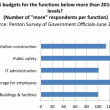How municipal utilities in rural areas can attract younger workers
As a wave of workers with vital institutional knowledge approaches retirement age, many agencies in the public sector are worried about how to contend with the so-called “silver tsunami.”
According to research focused on the water and wastewater sectors, these services will face an even more challenging environment. As many as 3 million positions—or about one-third of their total national workforce—will need to be filled in the coming decade.
Like many talent shortages, it’s no secret that water industry vacancies will be especially prevalent across small towns and rural areas. Decades of urbanization mean populations outside the city are aging rapidly, and this workforce issue simply won’t resolve on its own.
These issues show how important water-related jobs are for preserving and protecting communities. These small communities will need to take the following proactive measures to fill vital public-sector positions:
Extend outreach to local schools. It’s not always easy to convince high schoolers or recent graduates that a career in water is exciting, so it might be better to start getting children excited about the field in elementary or middle school. Provide funding for immersive, hands-on educational opportunities about the importance of water to spark a lifelong interest within a community’s youth. Likewise, be sure to educate older teens about management, treatment and engineering roles. Towns should invite young people to be inspired by the idea of ensuring a community has clean and safe water for its schools, businesses, homes and more.
In addition, consider partnering with community colleges to establish pipelines for utility companies. As traditional degrees grow exorbitantly expensive—and the returns on those investments become hazier—members of Generation Z are more open to a less conventional path than their parents (and perhaps even their older siblings). This is likely to continue with subsequent generations. According to a Brookings Institute study, 53 percent of water and wastewater industry workers have a high school diploma or less. Yet, these careers offer an increasingly uncommon pathway toward a stable middle-class future.
Look beyond the community. Water providers aren’t the only organizations that struggle to fill positions in small towns and communities. Part of building a pipeline of younger talent means making a community more attractive to younger generations. Many Millennials, for example, have had their financial footings shaken by the pandemic, meaning that financial assistance and incentives can be even more potent in attracting young residents.
Natchez, Miss., offers new residents an incentive package worth as much as $6,100, and it’s far from the only place to do so. Bentonville, a town in Northwest Arkansas that’s the birthplace of Walmart and known for its mountain biking trails, offers $10,000—and a bike. Other strong incentives for young talent include discounted housing or help with student loan payments.
Similarly, towns can try to work with employers willing to create new local jobs or move positions to rural areas. Utah recently opened its coffers when it wrote into law the Rural Economic Development Incentives program, for instance, which offers grant money to businesses for each full-time employee position they create and fill. States such as New York, Kentucky and Massachusetts are considering similar programs and funds that show promise as a means of investing in rural communities.
Encourage and incentivize homecoming initiatives. The ties that connect former rural residents to home can be surprisingly strong. Just take Rural Homecoming, a program organized by the Rural Community Assistance Partnership to foster stronger connections between rural communities and their former residents. One goal of the program is to celebrate the aspects of each community that make it unique, which former residents then share to amplify the messaging.
COVID-19 devastated the economies of small towns—many of which had been struggling before the pandemic—but it also opened up a sliver of opportunity. Countless organizations are offering employees the flexibility of remote work, which frees these young professionals and their families to move anywhere in the country. Likewise, epiphanies throughout the pandemic have encouraged many young people to take the plunge and explore new ways of life. With low costs of living, financial and community incentives, and other attractive programs, rural communities can draw a new influx of talent and hopefully fill vital public-sector positions in the process.
Chris Shaffner is the senior vice president of the Water and Community Facilities division at CoBank, a national cooperative bank serving vital industries across rural America by providing loans, leases, export financing and other financial services in all 50 states. Shaffner oversees the strategic growth and management of CoBank’s water infrastructure lending, rural healthcare investments and rural equity funds. He can be reached at [email protected].




















